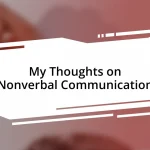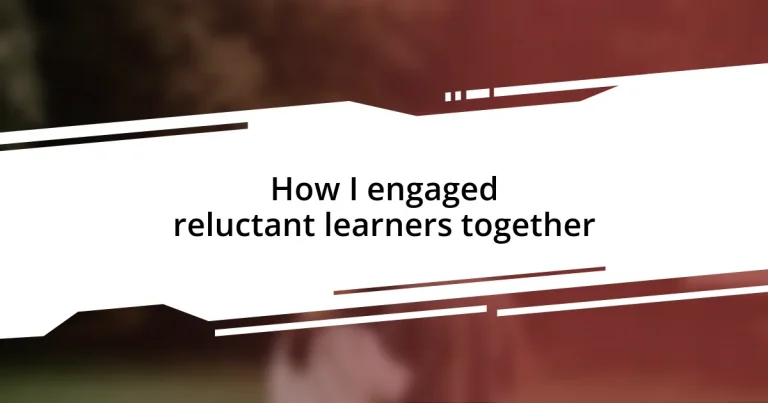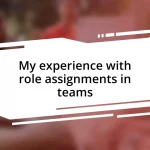Key takeaways:
- Understanding reluctant learners involves recognizing their personal histories, fears of failure, and the relevance of learning materials to their lives.
- Creating a supportive environment through strategies like establishing a “no judgment” zone and incorporating students’ interests can significantly enhance participation.
- Utilizing interactive teaching methods, such as hands-on activities and technology, fosters engagement and ownership of the learning process.
- Assessing engagement through feedback mechanisms like exit tickets and observation logs helps identify students’ comfort levels and informs tailored instructional approaches.
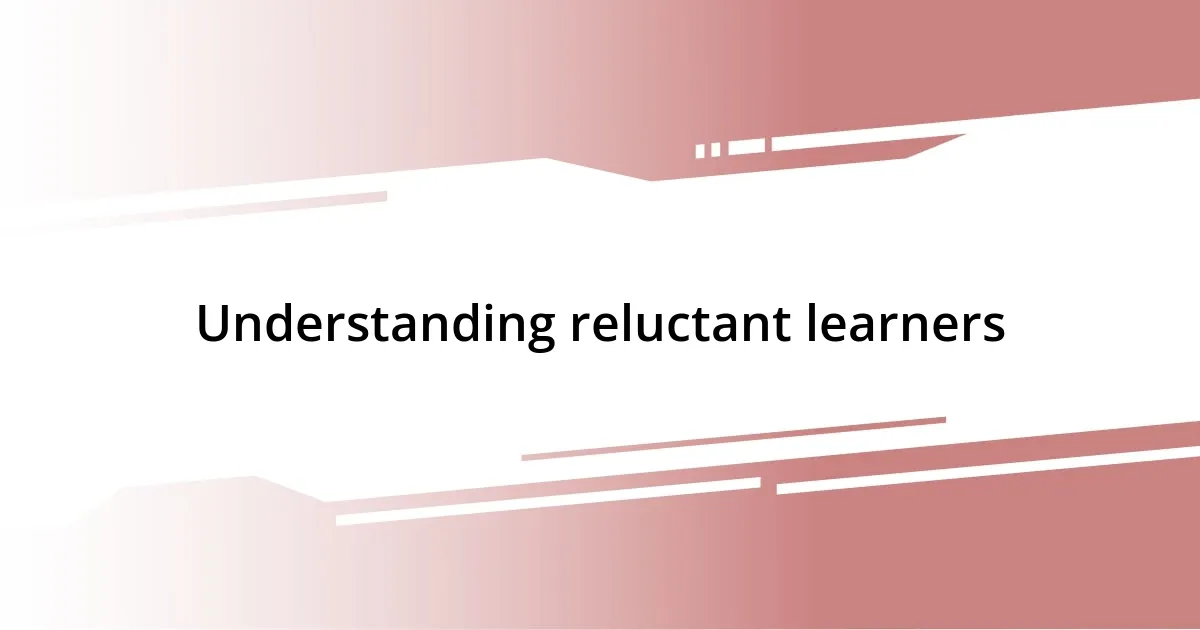
Understanding reluctant learners
Reluctant learners often carry a load of experiences that can overshadow their desire to engage. I remember one student who once told me that school felt like a never-ending cycle of failures, leaving him feeling defeated before he even stepped into the classroom. It’s these deep-seated emotions that can serve as barriers, making us wonder: what hidden stories are influencing their current mindset?
Understanding what drives reluctance can be a game changer. I’ve noticed that many students simply don’t connect with the material or see its relevance to their lives. For instance, there was a quiet girl in my class who wouldn’t raise her hand, yet when we discussed environmental issues, her eyes lit up. Was it that she hadn’t found her connection, or perhaps she didn’t feel safe to share her thoughts in a larger group? Exploring these connections is key to unlocking their potential.
Moreover, the fear of judgment often stifles their willingness to participate. I vividly recall a workshop where I encouraged a student to share his opinion, and his vulnerability opened a floodgate for others to join the discussion. It made me realize how crucial it is to create an environment where they feel valued and understood. How can we foster such spaces where reluctant learners feel empowered to express themselves? It’s a challenge that requires empathy and adaptability.
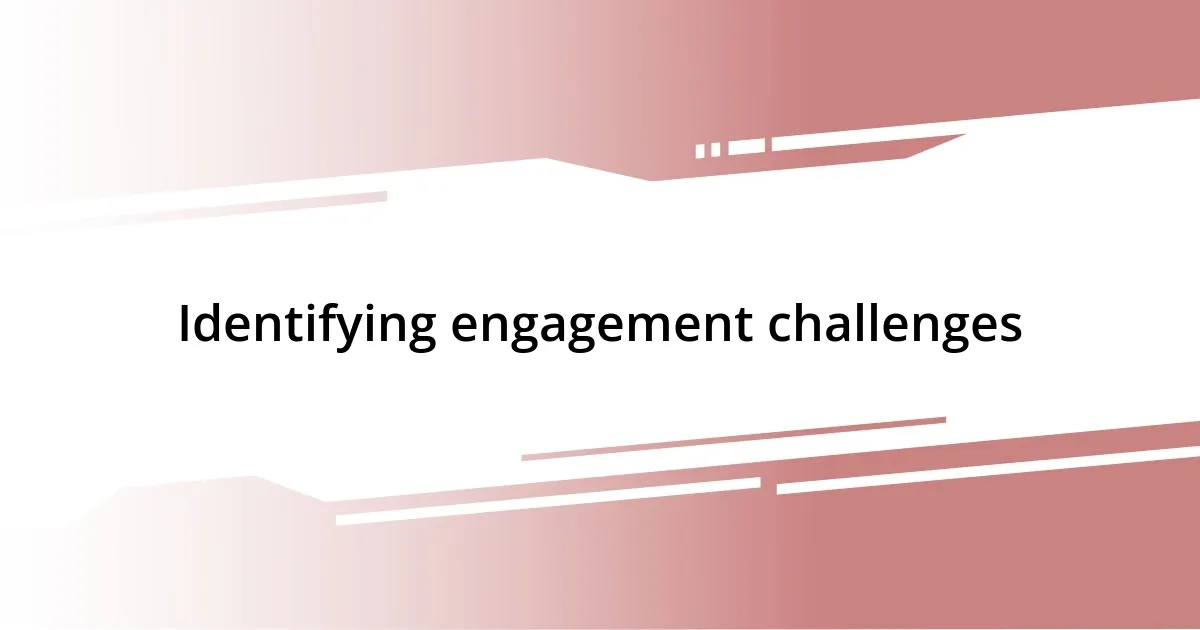
Identifying engagement challenges
Identifying engagement challenges is critical for transforming reluctant learners into active participants. In my experience, I’ve found that students often struggle with varying confidence levels, masking their eagerness to engage. One time, during a group project, I noticed a student who excelled in mathematics but was terrified of presenting to her peers. She was so bogged down by the fear of making mistakes that she ultimately went silent, even when her ideas could have enhanced the discussion. This reminded me that their trepidations can often stem from a combination of internal factors, such as self-doubt, and external factors, like previous negative experiences in school settings.
To effectively identify these challenges, I’ve learned to observe several key factors that often contribute to a lack of engagement:
– Personal History: Past experiences with learning can shape a student’s perceptions.
– Fear of Failure: Many students fear judgment, which can make them hesitant to participate.
– Relevance of Material: If they don’t see how the content applies to their lives, their interest tends to wane.
– Social Dynamics: Relationships within the classroom can influence a student’s willingness to engage.
– Learning Styles: Different approaches resonate uniquely with each student; one-size-fits-all methods often fall short.
Recognizing these challenges is the first step to fostering a supportive environment. By tuning into these subtle cues, I’ve pushed myself to create strategies tailored to individual needs, making sure each learner feels valued.
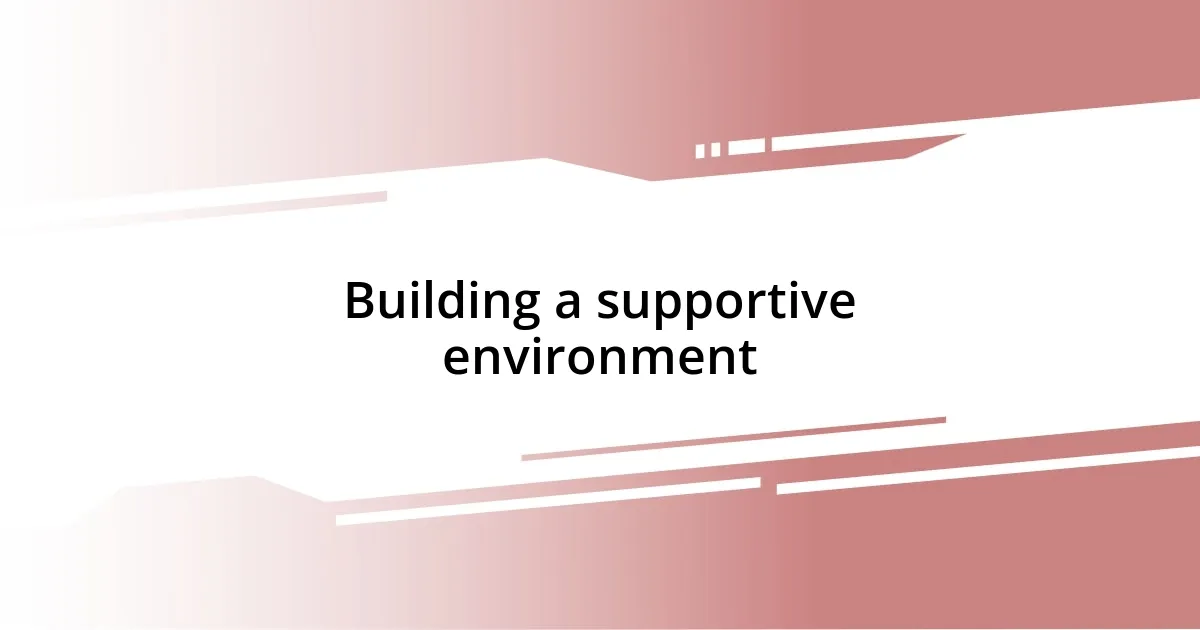
Building a supportive environment
Creating a supportive environment is essential for engaging reluctant learners. I remember a time when I implemented small group discussions in my classroom. Initially, a few students hesitated to share their thoughts. However, as I encouraged a culture of respect where every opinion mattered, I could see their shoulders relax. It was as if a weight had been lifted, allowing their voices to emerge from the shadows.
In my experience, setting clear expectations for behavior and participation can significantly enhance a learner’s willingness to engage. One time, I had a student who rarely contributed during our class discussions. After I established a “no judgment” zone where even the most unconventional ideas were welcomed, he finally spoke up. His simple yet insightful observation opened up a new dimension to our conversation, reminding me that when we create a safe, structured space, students can shine in unexpected ways.
The importance of building relationships cannot be overstated. I’ve always found that knowing my students on a personal level transforms the classroom dynamic. Taking the time to ask about their interests or hobbies has allowed me to connect learning material to what excites them. For example, I once learned that a student was passionate about video games. By incorporating game-based elements in a discussion about strategic thinking, I witnessed her transform from a wallflower to a lively contributor. It’s these connections that foster a supportive environment where students feel they truly belong.
| Supportive Environment Actions | Potential Outcomes |
|---|---|
| Establish a “no judgment” zone | Students feel safe to share ideas |
| Implement small group discussions | Increases participation rates |
| Incorporate students’ interests | Boosts engagement and relevance |
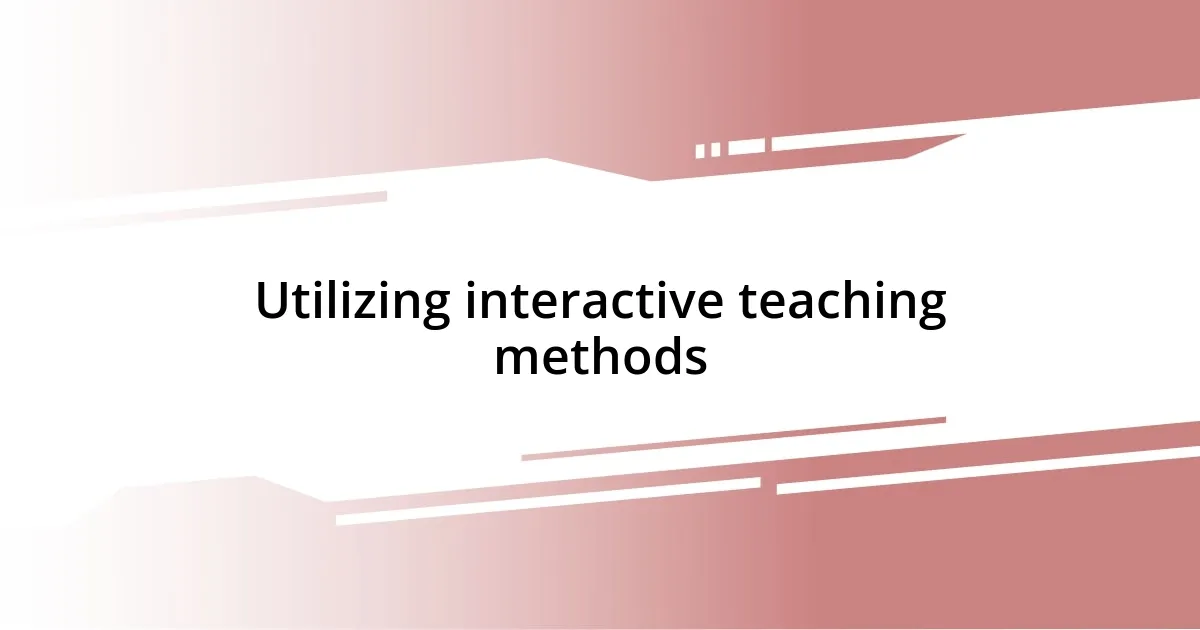
Utilizing interactive teaching methods
Utilizing interactive teaching methods can be a game-changer for reluctant learners. I remember a particularly memorable lesson where I incorporated a hands-on activity related to our science curriculum. Instead of a standard lecture, I set up an experiment that allowed students to work in pairs to explore chemical reactions. The excitement in the room was palpable as they mixed common household substances, and suddenly, these once-reluctant learners were debating the results! It’s moments like these that reaffirm my belief in the power of interactive learning.
What I’ve found is that using technology, like interactive quizzes, can also significantly boost engagement. One day, I decided to pull out a quiz app during a review session. Rather than simply lecturing on the material, students eagerly competed against each other on their devices. The shift in energy was almost electric; students who usually sat quietly suddenly became active participants, cheering for their teammates and celebrating victories, no matter how small. It made me wonder: what if we could harness that competitive spirit more often?
Additionally, I’ve explored project-based learning, where students can work on real-world issues. In a recent class, I encouraged my students to find solutions to local environmental problems. Watching them brainstorm ideas was truly inspiring. They became not just students fulfilling a requirement, but passionate advocates for change, energized by the knowledge that their ideas mattered. It struck me, how often do we overlook the potential in our learners when we fail to connect lessons to a larger purpose? This interactive approach not only engages students but also cultivates a sense of ownership over their learning journey.

Incorporating relevant materials
Incorporating relevant materials is a strategy that can make a world of difference when working with reluctant learners. For instance, when I introduced a literature unit, I chose texts that reflected the diverse experiences of my students. One boy, typically disengaged, was drawn to a short story featuring a character he could relate to. I still remember the spark in his eyes as he connected his life to the narrative, transforming a mundane lesson into a deeply personal experience. Isn’t it fascinating how relevant materials can ignite a passion for learning?
One approach I found particularly effective is connecting lessons to current events. I recall using news articles about climate change to discuss scientific principles. Students who previously showed little interest suddenly became active participants, debating the implications of the articles. Their awareness deepened and their engagement soared. This experience made me realize that when we tie learning to the real world, it becomes more significant. It begs the question: how often do we miss opportunities to connect lessons to what’s happening outside the classroom?
Moreover, incorporating multimedia resources can also captivate reluctant learners. I once included videos in a history lesson about civil rights, showcasing powerful speeches and moments that shaped our society. Seeing their reactions—some were moved to tears—was a poignant reminder of how visual stories can humanize history. I caught myself thinking: how can we expect students to invest in their education if we don’t present it in a way that resonates with them? These materials create emotional connections that can pave the way for deeper comprehension and retention.
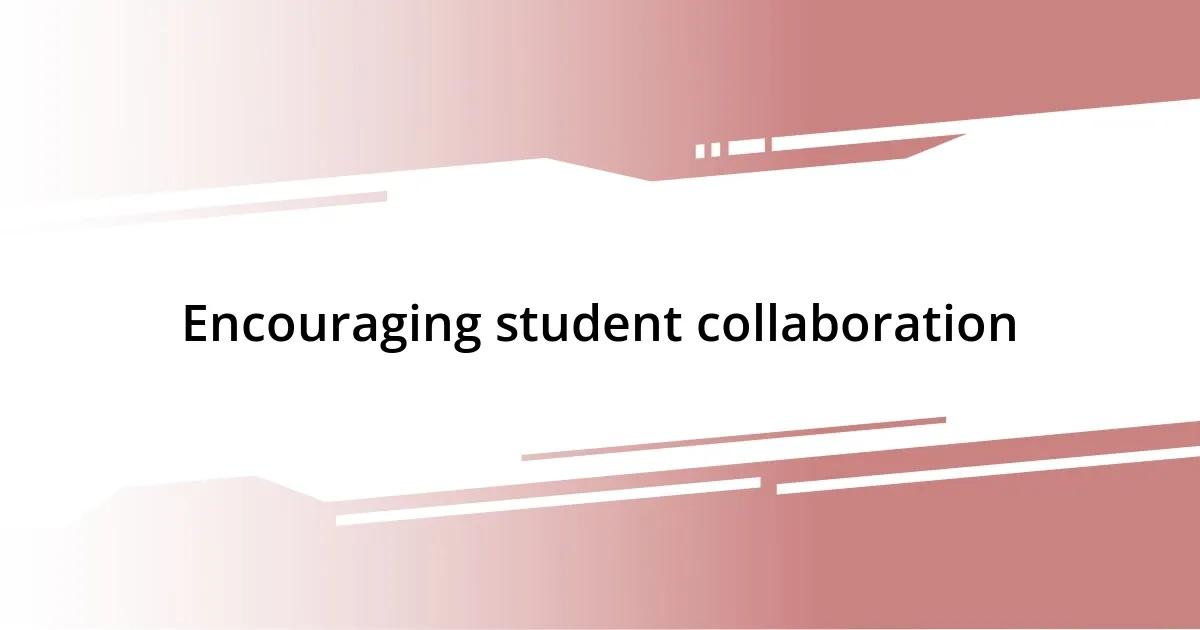
Encouraging student collaboration
Encouraging collaboration among students can truly transform their learning experience. I distinctly remember a project where I paired students with varying skill levels to tackle a complex problem. Initially hesitant, they gradually began to share ideas and strategies. I was amazed to see how the quieter student found confidence by explaining his thought process to a peer who was struggling. Don’t you think it’s incredible how collaboration can foster skills beyond academics, like communication and teamwork?
There’s something special about watching students take ownership of their learning through collaboration. I once organized a debate on a topic relevant to their lives, and groups formed organically, drawing in everyone—from those who typically sat silently to the vocal students who thrived on discussion. As they prepared, I noticed a shift in dynamics; students were not just discussing facts but shared personal opinions and lived experiences. Isn’t it heartwarming to see them connect in that way, learning not only from the material but from each other?
One of my favorite experiences was when I introduced peer teaching, where students would take turns explaining concepts to one another. Initially, I thought this might be chaotic, but it turned out to be a revelation. I vividly recall a student explaining a math problem to his classmate with such enthusiasm; his eyes lit up as he broke down steps he had once struggled with himself. How often do we recognize that teaching someone else can reinforce our own understanding? The sense of camaraderie that emerged was palpable, and it reinforced my belief that collaboration is a powerful tool for reluctant learners.
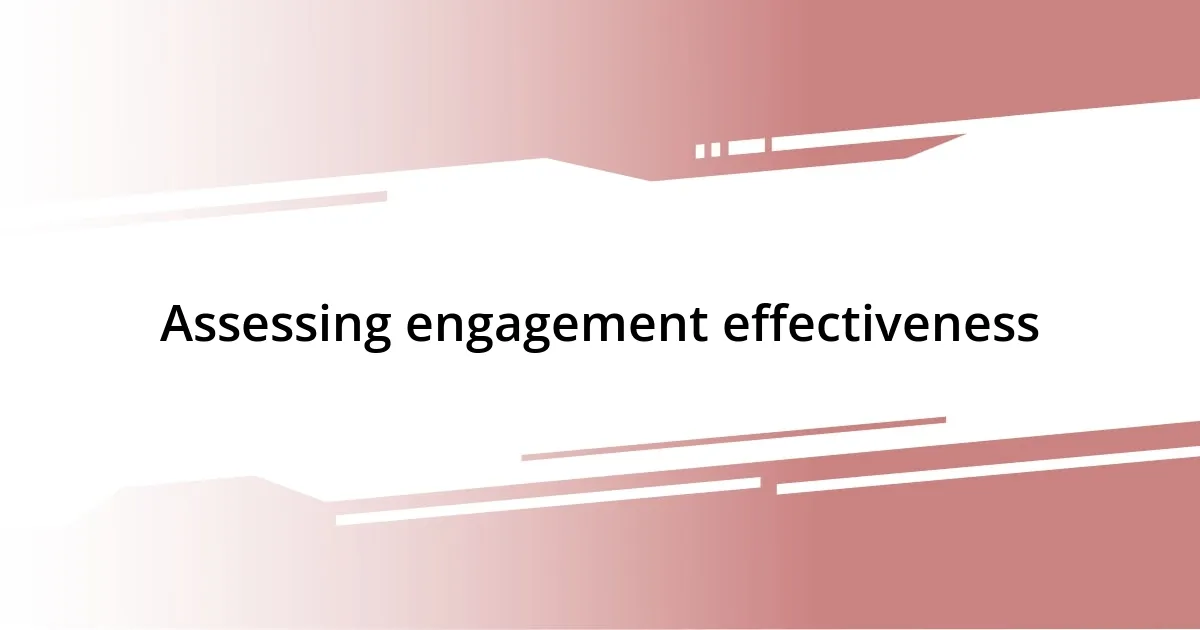
Assessing engagement effectiveness
Assessing engagement effectiveness is crucial in understanding how to best reach reluctant learners. During my teaching journey, I implemented simple feedback mechanisms, like exit tickets, to gauge students’ interest and comprehension after each lesson. One day, I was surprised to find that students who rarely spoke up were eager to share their thoughts, providing insight that something resonated with them. Isn’t it eye-opening how tools like this can reveal hidden engagement levels?
I also remember a time when I used surveys to evaluate the impact of a group project on students’ collaboration skills. The responses were a mix of excitement and apprehension—some students felt empowered, while others admitted to feeling out of their comfort zone. This dichotomy sparked an important realization for me: engagement varies not just in intensity but also in comfort levels. With this knowledge, I adapted future projects to accommodate these different styles. Have you ever noticed how some students thrive in structured environments while others flourish with freedom?
In another instance, I incorporated observation logs where I would jot down behavioral changes during discussions. One particular student, who usually sat quietly in the back, surprised me by actively contributing ideas during a collaborative brainstorming session. Reflecting on this, I recognized that even small shifts in participation can signal significant engagement breakthroughs. It makes me wonder: how often do we overlook subtle signs that show a learner is beginning to connect? These varied assessment tools have been instrumental in shaping my approach, ensuring I foster an environment where every student feels heard and valued.











